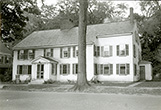
Art Center
Concord Journal, May 12, 1938
This house [now 37 Lexington Road] stands on the seventeenth century lot of Thomas Dane who bought six acres above the road and one acre below the road in 1657 from Rev. Peter Bulkeley. There is still a cave in the hillside behind it, which recalls vividly the fact that Concord’s first settlers lived in caves on this south side of the ridge. Here or near here was the cave of first settler George Hayward, who sold his lot to his pastor when he moved out to the west of the river. His descendants had a mill in West Concord, near the site of Damon’s Mill.
The deed to Thomas Dane specifies that he was to pay for the land in boards delivered to Charlestown, so we know that he had the material to build a regular house. This he left in his will to his son Joseph and the next owner was William Clark who sold it in 1724 to his brother in law, Jonathan Ball, innholder, who kept an inn in the house (probably enlarged at this time), which now belongs to Mrs. Newell Garfield. Before 1755, however, this house which we know as the Art Center, had been built, for in that year John Ball, goldsmith and son of Jonathan, deeded the house and six acres to Simon Hunt and Thomas Barrett, excluding in the southeast corner “an old house of my own,” half the well and the easterly half part of the house during the natural lives of his parents.
Joseph Butler, another innholder, was the next owner and he sold it in 1775 to Thomas Cordis. In this deed the land was reduced to a lot seven rods wide and four rods deep and the house was called a dwelling and goldsmith’s shop. Thomas Cordis came to Concord because his father Mr. Cord Cordis “sugar baker of Boston” married Hannah, the young widow of the senior Elnathan Jones. Thomas Cordis, too, died young, and was buried in the Main Street burying ground, and his widow Elizabeth married Jonas Lee, a radical son of a tory father, who continued to occupy it after her death and even enlarged it for his fourth wife, the widow Colburn. There is a so-called secret room in the house, which may have been the goldsmith’s strong room.
Jonas Lee was leader of the Democrats against the Federalists during the close contests of the early eighteen hundreds. There was often only one vote separating the two parties, and the poll would be taken by a division, the two parties marching in single file out of the court house into the square, where there was often fist fighting. Lee was elected to the legislature in 1806, 1808 and 1814. His fourth wife was a match for him in temper. The story is told that when he built the east addition to his house, he ordered the mason to build the fireplace in the side, she in the corner. As fast as the mason laid the bricks on the side, she kicked them over, until the man left in disgust.
For the later history of the house, I am indebted to the title abstract made by Mr. Roger Swaim for Miss Roberts: Samuel Cordis Lee and to Charles E. Davis, 1827; Lucy Ann Smith to Joshua R. Brown, 1844; Brown to Samuel Staples, 1849; Staples to Joel Walcott, 1849; Walcott to Sharlot B. Worcester, 1916; Worcester to Lawrence Park, 1920; Park to Elizabeth D. Roberts, 1922.
Samuel Lee’s sister Sally married Nathaniel Munroe, the clock maker and they lived in the west half before 1827. Charles B. Davis was the brother of Josiah and Jonathan Davis who had a store across the street. His daughter Jennie and her husband, Dr. R. W. Wood of Honolulu later lived here. The Walcotts lived next door and fitted up the east end for the son Charles H. Walcott on his marriage to Florence Keyes in 1875, and after her death in 1877, he continued to live here with his brother Horace and later with John L. Gilmore.
Miss Roberts bought the house in 1922 for the Concord Art Association, built a gallery in the upper story where interesting exhibitions are held every summer. The east wing has been remodeled for the custodian.